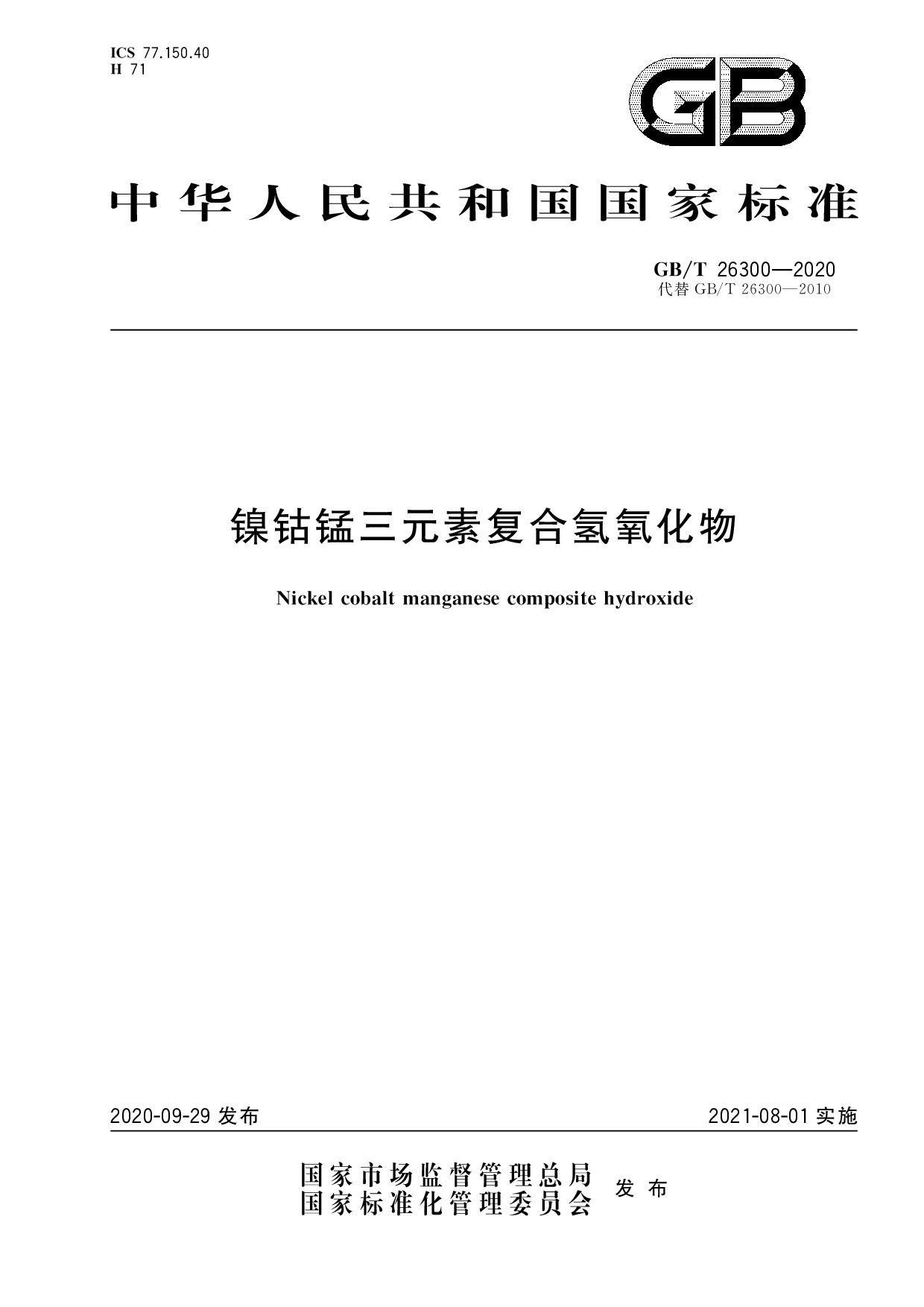GB/T 26300-2020
Nickel cobalt manganese composite hydroxide (English Version)

- Standard No.
- GB/T 26300-2020
- Language
- Chinese, Available in English version
- Release Date
- 2020
- Published By
- General Administration of Quality Supervision, Inspection and Quarantine of the People‘s Republic of China
- Latest
- GB/T 26300-2020
- Replace
- GB/T 26300-2010
- Scope
- This standard specifies the classification, technical requirements, test methods, inspection rules, packaging, marking, transportation and storage, quality certificate and purchase order (or contract) content of cobalt-manganese three-element composite ammonia oxide. This standard is applicable to nickel-bath-manganese three-element composite oxygen oxide, whose chemical formula is NiCovMn_(OH); (where Z+y=1, Z=0 and y>0).
- Introduction
Core changes in the standard revision
Technical dimensions 2010 version 2020 version Key changes Grade system Old naming rules NCMH+6-digit code New 3/4-digit code system Chemical composition Cl-/Si is not restricted Cl-/Si is deleted, and the limit values of Na/Zn, etc. are adjusted Impurity control is stricter Physical properties Loose density indicators Loose apparent density ≥0.50g/cm³
Tapped density ≥1.10g/cm³Improved compaction performance requirements New indicators None Magnetic foreign matter ≤0.00001% Coping with the safety of high-nickel materials
Analysis of key technical requirements
Chemical composition control
The total amount of nickel, cobalt and manganese in the product must be controlled within 60.00%-64.00%, and the tolerance of the amount fraction of each element shall be ≤±1.00%. Typical products such as NCMH831205 (Ni83:Co12:Mn5) must ensure that the nickel content is within the range of 82.00-84.00%.
Physical performance indicators
- Particle size distribution: D50 is controlled at 2.00-21.00μm
- Specific surface area: 2.00-30.00m²/g
- Morphology requirements: must be spherical/quasi-spherical particles
Detection method upgrade
Magnetic foreign matter detection
GB/T 24533-2019 Appendix K method is adopted, and the detection is carried out using a high gradient magnetic separator, with a detection limit of 0.1ppb. A case of a certain enterprise shows that the content of magnetic foreign matter can be reduced from 0.00005% to 0.000008% by adding a magnetic rod filtration process.
Material fraction calculation
Added normative Appendix A, specifying the formula:
XNi=(WNi/58.69)÷(WNi/58.69+WCo/58.93+WMn/54.94)×100%
The calculation result is rounded to 0.01%
Implementation suggestions
- Establish a magnetic foreign matter control system, and it is recommended to add a magnetic filtration device before the drying process
- For high nickel products (such as NCMH900604), the sodium content must be controlled to ≤0.030%
- It is recommended to use the Karl Fischer method for moisture detection, and the control point is set in the pre-packaging process
GB/T 26300-2020 Referenced Document
- GB/T 1479.1 Metallic powders—Determination of apparent density—Part 1:Funnal method
- GB/T 19077 Particle size analysis by laser diffraction*, 2024-10-26 Update
- GB/T 19587 Determination of the specific surface area of solids by gas adsorption using the BET method
- GB/T 24533 Graphite negative electrode materials for lithium ion battery
- GB/T 26300 Nickel cobalt manganese composite hydroxide
- GB/T 5162 Metallic powders—Determination of tap density*, 2021-03-09 Update
- GB/T 5314 Powders for powder metallurgical purposes.Sampling
- GB/T 8170 Rules of rounding off for numerical values & expression and judgement of limiting values
- JY/T 010 General principles of analytical scanning electron microscopy
GB/T 26300-2020 history
- 2020 GB/T 26300-2020 Nickel cobalt manganese composite hydroxide
- 2011 GB/T 26300-2010 Nickel cobalt manganese composite hydroxide